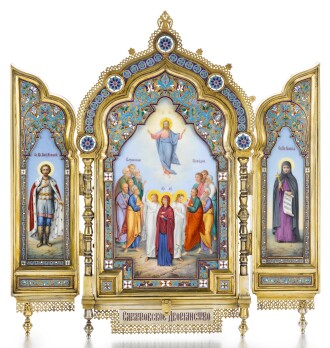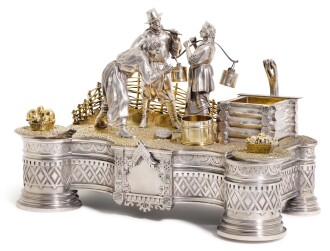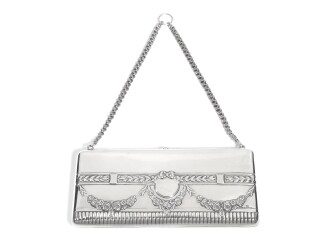By the time of his death, Ivan Khlebnikov had served as official supplier of the Imperial Russian family, the Grand Dukes, and the sovereigns of Denmark, the Netherlands, Serbia and Montenegro. Khlebnikov’s international acclaim stemmed from the numerous exhibitions he participated in, especially those in Vienna (1873) and Moscow (1872) - he won two gold medals at each of these. His company was known for producing decorative silver and enamel work which reinvented traditional Russian style and folk art through originality and a colourful palette. In particular, Khlebnikov was known for immaculate plique-à-jour and cloisonné enamel, and for works produced in the Russian and Modern styles. Nevertheless, Khlebnikov’s output was extremely diverse and also featured the Neo-Baroque, -Rococo and -Classical styles.
Khlebnikov’s remarkable career began in 1867, when this son of a jewellery and diamond merchant opened his own jewellery firm in St Petersburg. His three sons Nikolai, Mikhail and Alexei were employed in his workshop and, upon their father’s death in 1881, took over the firm and expanded it greatly. In 1871, Khlebnikov moved the business from St Petersburg to Moscow. By 1882, around two hundred artisans were employed at the firm, and Khlebnikov also established an in-house school of design and sculpture for thirty-five students.
Two of Khlebnikov’s most significant projects were the renovation of the Palace silver dinner sets, working alongside Nichols & Plinke, Ovchinnikov and Morozov, and the decoration of Christ the Saviour, for which his firm produced nearly fifty religious objects such as chalices, incense burners, icon lamps and much else. Khlebnikov’s more commercial work for the mass market centred largely around dinnerware and jewellery.
When the Russian Revolution began in 1917, Khlebnikov’s sons closed the firm and donated their shares to the Moscow county zemstvo , or local government.
10 Russian Art & Silver Highlights from the James F. Scott Collection
10 Russian Art & Silver Highlights from the James F. Scott Collection
A Russian silver-gilt Icon of the Tikhvin Mother of God, Moscow, 1831. Estimate $4,000–6,000.
A Russian silver-mounted and gem-set Karelian birch notepad, Faberge, Moscow, 1908-17. Estimate $4,000–6,000.
Czarevich Alexei Nikolaevich: Two pairs of skis and a pair of boots, A.B. Otto Brandt, Helsinki, circa 1910. Estimate $50,000–60,000.
A Russian silver and enamel-mounted photograph album, Khlebnikov, Moscow, circa 1895. Estimate $5,000–7,000.
A set of Russian Cossack boy's and girl's costumes. Estimate $1,000–2,000.
A Russian two-color gold mounted nephrite frame, Faberge, workmaster Michael Perchin, St. Petersburg, circa 1890. Estimate 12,000–15,000.
A Russian Imperial Presentation silver-gilt and cloisonné enamel place setting, Grachev, dated 1895. Estimate $10,000–15,000.
A pair of large Russian silver-mounted cut-glass vases, Ivan Khlebnikov, 1908-17. Estimate $15,000–20,000.
A Russian parcel-gilt silver and enamel large Imperial Presentation photograph frame, Faberge, 1899-1908. Estimate $40,000–50,000.
A porcelain plate from the Order of St. Vladimir service, Gardner Porcelain Factory, Verbilki, 1783-85. Estimate $6,000–8,000.
Close
Fine Russian Ceramics and Gilt Silver from a Life on the French Riviera
Fine Russian Ceramics and Gilt Silver from a Life on the French Riviera
A Russian Porcelain Vase, Imperial Porcelain Manufactory, St Petersburg, Period of Alexander III, 1889-1891. Estimate: €80,000–120,000
This impressive vase was presented on behalf of Emperor Alexander III to Phillip Schou, the director of the Royal Copenhagen Porcelain Manufactory, in August 1893. Alexander III, a connoisseur and collector of works of art, displayed a keen interest in the artistic activities of the Imperial Porcelain Factory. His wife, Maria Feodorovna born Princess Dagmar of Denmark, must surely have encouraged this interest. The relationship with Royal Copenhagen ensured that the Imperial Manufactory in Saint Petersburg stayed up to date with the recent techniques and mastered the traditions on its northern neighbors, including underglaze painting techniques.
A Russian Porcelain Vase, Imperial Porcelain Manufactory, St Petersburg, Period of Nicholas II, dated 1913. Estimate €30,000–50,000.
Decorated with delicate flowers, this slender vase was presented by Empress Alexandra Feodorovna to Count Vladimir Borisovich Freedericksz in 1917. As head of the Ministry of the Imperial Court, Freedericksz worked closely with the Empress and her husband, Tsar Nicholas II. The vase stayed with the family for almost a century, travelling to Finland and then Sweden after the descendants left the new Soviet state for the West.
An Important Russian Porcelain Vase, Imperial Porcelain Manufactory, St Petersburg, Period of Nicholas II, 1898-1901. Estimate €30,000-50,000.
An impressive example of turn of the century style, this vase elegantly combines traditional decorative patterns with a realistic marine painting, after G. Zimin Goloffri and was mentioned in the 1901 inventory of the Imperial Porcelain Manufactory.
A Russian Porcelain Vase, Imperial Porcelain Manufactory, St Petersburg, Period of Alexander III, marked and dated 1885. Estimate €80,000–120,000.
Produced in the reign of Emperor Alexander III, this vase is decorated by a harbour scene after Claude Lorrain's Morning in the Harbour , now in the Hermitage Museum collection. Skilfully made copies of masterpieces from the Imperial collection were a popular subject of decoration for important 19th century pieces, often intended for presentation or important gifts.
Two Large and Rare Porcelain Serving Dishes from the Kremlin Service, Imperial Porcelain Manufactory, St Petersburg, Period of Nicholas I (1825-1855). Estimate €15,000–20,000.
This service was commissioned for use in the Great Kremlin Palace, the official Moscow residence for the Imperial family, when the process of renovating, and ultimately rebuilding, the palace began in 1837. The task of designing the new service fell to the talented student and future professor of the Academy of Arts Fedor Solntsev, who had been studying and recording Russian antiquities. The Kremlin Service was intended for five hundred people, with two thousand dinner plates, one thousand soup plates, and one thousand dessert plates.
A Fabergé Agate and Silver-Mounted Bowl, Karl Gustav Armfelt, St Petersburg, 1899-1908. Estimate €50,000–70,000.
One of Fabergé’s most important clients, the oil magnate Emanuel Nobel, is known to have commissioned some of his most important pieces directly from the Fabergé workshop of Karl Armfelt.
Four Silver-Gilt Plique-À-Jour, Guilloché and Champlevé Enamel Sherbet Cups and Stands, Antip Kuzmichev and Khlebnikov, Moscow, 1896-1908. Estimate €40,000–60,000.
This dessert set illustrates the quality and variety of Russian enamelling techniques: cloisonné, champlevé and guilloché masterfully combine shapes and forms with vivid colours in the distinctly Russian style so favoured at the time.
A Silver and Cut-Glass Caviar Cooler in the form of a live Sturgeon, Kurlyukov, Moscow, 1908-1917. Estimate €50,000–70,000.
This impressive caviar dish was a gift from Emmanuel Nobel to Knut Henrik Littorin, who worked for the family from the late 19th century up until the Russian Revolution. As prominent collectors of exceptional Fabergé and other Imperial Russian pieces, the Nobel family must have recognised the scale and the craftsmanship of this outstanding sixteen-piece set.
A Silver-Gilt and Niello Tea and Coffee Service, Pavel Ovchinnikov and Vasiliy Semenov, Moscow, 1875 and 1876. Estimate €30,000-50,000.
Skilfully nielloed with the views of the Moscow Kremlin, this set is especially outstanding due to being preserved in full, unlike many comparable groups from this period. All of the twenty-one pieces are delicately decorated and gilt with the traditional woven ornament and insulated with original ivory.
A Soviet Porcelain Figure of the Ballerina in the role of Zobeida in Rimsky-Korsakov's 'Sheherazade', State Porcelain Manufactory, Petrograd, circa 1930, after a 1923 design by Dimitri Iosifovich Ivanov. Estimate €5,000–7,000.
Modelled as ballerina Tamara Karsavina as Zobeida in Rimsky-Korsakov's 'Sheherazade', this figurine part of the series celebrating the stars of the turn of the century ballet and theatre scene. A principal dancer at the Mariinsky Theatre in Saint Petersburg and then at Serge Diaghilev's Ballets Russes, Karsavina is depicted wearing the original costume design by Léon Bakst.
A Group of Silver-Gilt Plates and Serving Pieces from the Orloff Service, Carl Tegelsten, Nicholls & Plincke and Ivan Morozov, St Petersburg, 1850. Estimate €60,000–80,000.
The pieces in this impressive silver-gilt group were ordered to supplement the famed Orloff Service, originally commissioned by Empress Catherine the Great. One of the greatest French silver services of the eighteenth century, the service was supplemented throughout the nineteenth century by the leading silversmiths of St. Petersburg.
Close
Read Less



















